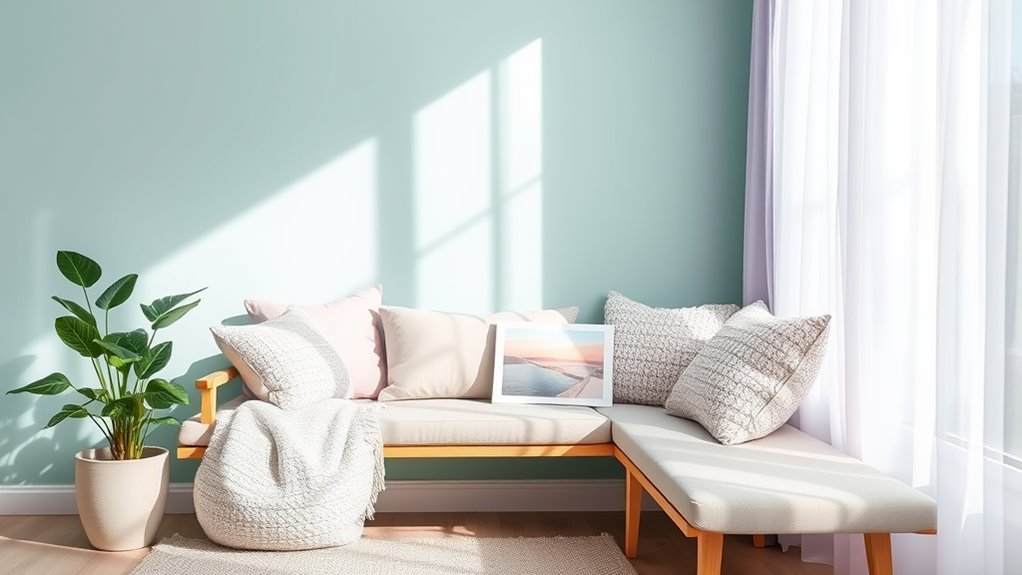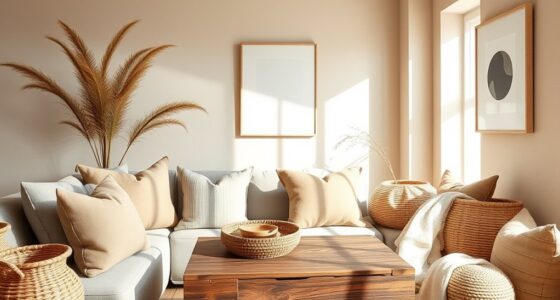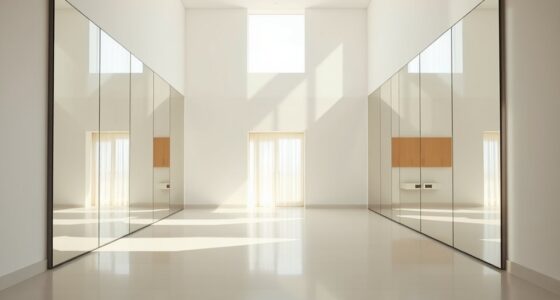To reduce stress through decor, focus on soothing colors like soft blues, aquas, and gentle greens to create calmness and balance. Incorporate earth tones, muted pinks, warm neutrals, and soft yellows for cozy, comforting spaces. Balance bright hues with calming shades and add natural elements like botanical accents and textures. These color therapy ideas help promote emotional stability and relaxation, so if you keep exploring, you’ll discover more ways to transform your space into a stress-relieving sanctuary.
Key Takeaways
- Use soothing blues, aquas, and gentle greens to promote calmness, emotional balance, and relaxation.
- Incorporate earth tones and muted pinks for a grounding, cozy, and emotionally nurturing environment.
- Add warm neutrals and soft yellows to create inviting, positive spaces that enhance comfort and optimism.
- Pair bright colors with calming shades like blue or green to balance energy and promote tranquility.
- Include floral accents and natural textures such as wood and botanical elements to foster serenity and mindfulness.
Embrace Soft Blues and Aquas for Calmness

Soft blues and aquas are perfect choices if you’re aiming to create a calming atmosphere in your space. These colors carry strong symbolism of tranquility and clarity, helping to promote a peaceful environment. When you incorporate soft blues and aquas, you’re enhancing mood by encouraging relaxation and reducing stress. These shades are known for their soothing effects, making them ideal for spaces where you want to feel calm and centered. Their gentle hues can also evoke feelings of openness and freshness, which contribute to a positive mental state. Additionally, layer textures and colors can amplify the cozy, inviting atmosphere created by these calming shades. By choosing soft blues and aquas in your décor, you set a tone of serenity that can improve your overall mood and foster a sense of well-being. This simple shift can make a significant difference in your daily stress levels.
Incorporate Gentle Greens to Promote Balance
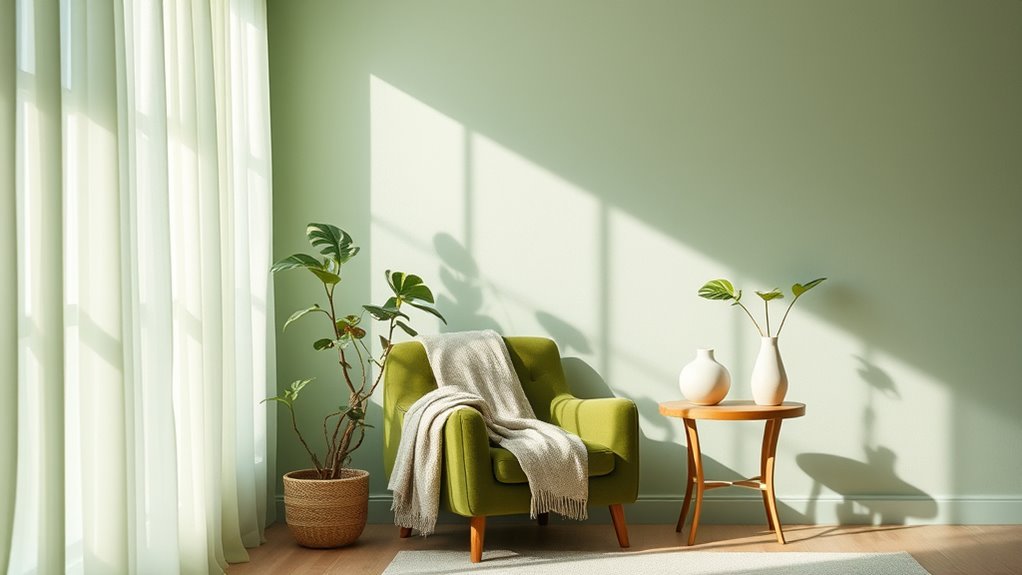
Incorporating gentle green shades into your décor can create a soothing atmosphere that promotes balance. Use natural elements like plants and wood accents to enhance this calming effect. When you blend these greens with organic materials, you foster harmony and a sense of well-being in your space. Additionally, choosing appropriate hues of green can further amplify the stress-relieving qualities of your décor.
Soothing Green Shades
Gentle green shades have a calming effect that can help create a balanced and restful environment. In color psychology, green is associated with renewal and harmony, making it ideal for promoting emotional well-being. When you incorporate soothing green hues into your space, you encourage a sense of tranquility that reduces stress and enhances relaxation. These soft shades serve as a visual reminder of nature’s calming influence, helping you feel more centered and at peace. Whether used on walls, accessories, or textiles, green shades foster a soothing atmosphere that supports mental clarity and emotional stability. By choosing gentle greens, you create a sanctuary where stress melts away, allowing your mind and body to find balance and renewal. Additionally, personality traits such as openness and emotional resilience can enhance your ability to fully benefit from a calming environment.
Natural Elements Integration
Integrating natural elements into your décor enhances the calming effects of green shades while grounding your space in the serenity of nature. Botanical accents, like potted plants or fresh flower arrangements, bring lively energy and visual interest. Incorporate natural textures such as wooden furniture, woven baskets, or linen fabrics to add tactile warmth and authenticity. These elements create a seamless connection between your indoor environment and the natural world, promoting relaxation and balance. When you include greenery and natural materials, you foster a soothing atmosphere that reduces stress and encourages mindfulness. Regularly assessing and organizing your space ensures that clutter does not detract from the calming influence of these natural elements. Keep the palette soft and harmonious, allowing the textures and botanical details to serve as gentle focal points. This integration cultivates a tranquil space that nurtures your well-being every day.
Balance and Harmony
To create a balanced and harmonious space, you should focus on using soft green hues that promote a sense of calm and stability. Green’s psychological effects foster relaxation, reducing stress and encouraging mental clarity. In color psychology, gentle greens symbolize renewal and equilibrium, helping you feel grounded. Incorporating these shades can enhance your environment by balancing energy and promoting emotional well-being. Consider the following ideas:
| Element | Green Shade | Effect |
|---|---|---|
| Wall Paint | Sage Green | Soothing backdrop |
| Textiles | Mint or Olive Green | Calming accents |
| Décor Accessories | Soft Lime Green | Fresh, vibrant touches |
This combination creates a peaceful atmosphere that supports mental harmony and stress relief. Color psychology plays a vital role in selecting shades that foster emotional stability and a sense of tranquility.
Use Warm Neutrals to Create a Cozy Atmosphere

Using warm neutrals can instantly make your space feel inviting and comfortable. Incorporate soft neutral palettes as your base, then add warm accent accents to enhance the cozy vibe. These simple choices help create an environment that feels both soothing and welcoming. Consider using self-watering plant pots to maintain healthy, well-hydrated plants effortlessly, further contributing to a relaxing atmosphere.
Subheading 1: Soft Neutral Palettes
Warm neutrals like beige, taupe, and soft browns instantly create a welcoming and calming environment. By leveraging color psychology, these shades promote relaxation and reduce stress, making your space feel safe and cozy. Consider how room lighting enhances this effect; soft, warm lighting accentuates the gentle tones, amplifying their soothing qualities. You’ll find that neutral palettes serve as a perfect backdrop for relaxation, allowing you to unwind effortlessly. These colors also provide versatility, blending seamlessly with other hues or accents if you want to add subtle variety later. When choosing soft neutral palettes, focus on maintaining consistent tones and warm lighting to maximize their calming impact. Additionally, understanding the role of attention in creative practice can help you create a mindful space that supports relaxation and mental clarity. This creates a stress-relieving atmosphere that invites tranquility and comfort.
Subheading 2: Warm Accent Accents
Incorporating warm neutrals as accents instantly enhances the coziness of your space. Use these tones to create a comforting atmosphere with complementary color schemes that balance warmth and harmony. Add mood-boosting accessories like plush cushions, soft throws, and textured rugs to elevate relaxation. Consider these elements:
- Rust-colored throw pillows that invite touch and warmth
- Cream-toned vases paired with deep terracotta artwork
- Warm beige candles flickering softly on side tables
- Copper or bronze decorative accents that reflect cozy light
These accents make your space feel inviting and calm, perfect for stress relief. By carefully selecting color schemes and mood-boosting accessories, you craft a space that nurtures relaxation and comfort effortlessly.
Add Touches of Lavender and Lilac for Serenity
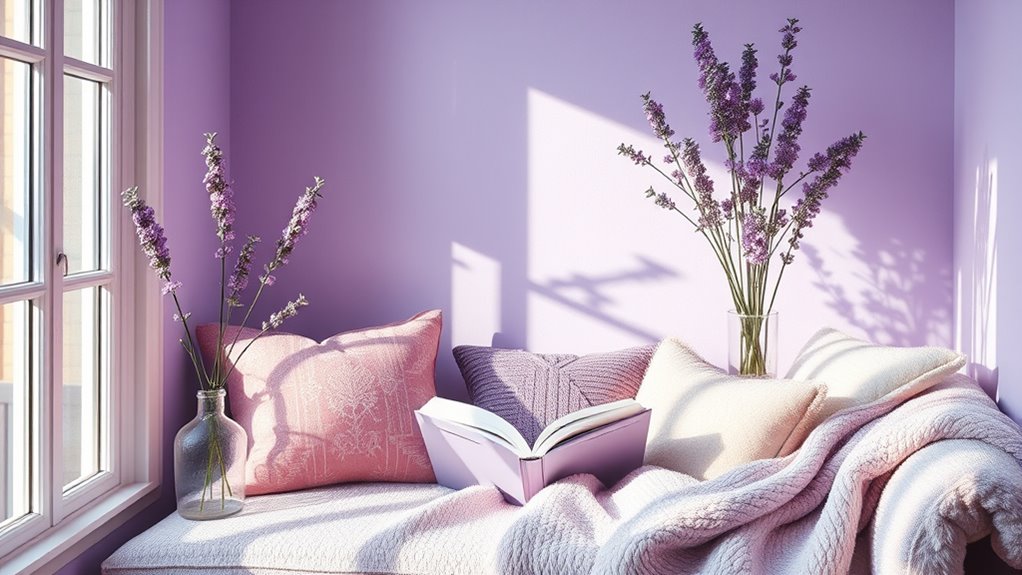
Adding touches of lavender and lilac can instantly create a calming atmosphere in your space. These colors are known for their psychological effects, promoting relaxation and reducing stress. Lavender’s cultural significance as a symbol of serenity and purity enhances its soothing qualities. Incorporate these shades through flowers, throw pillows, or wall art to foster tranquility. For instance, the use of colors in décor can significantly influence your mood and well-being.
Integrate Earth Tones for Grounding and Stability

Building on the tranquil energy created by lavender and lilac, earth tones deepen that sense of stability and grounding in your space. In color psychology, earthy shades evoke feelings of safety and balance, making them perfect for stress relief. Use these decorating tips to incorporate earth tones effectively:
- Paint walls in warm beige or soft taupe to create a cozy backdrop.
- Add wooden furniture or accents to bring natural texture.
- Incorporate terracotta or clay-colored accessories for warmth.
- Use woven baskets or rugs in moss green or deep brown to enhance grounding.
- Incorporate vintage decor for authentic farmhouse charm to complement the earthy palette.
These earthy hues help anchor your environment, promoting calm and mental clarity. Integrating earth tones with intentional decor encourages a stable, peaceful atmosphere that soothes your mind and body.
Choose Muted Pinks for Comfort and Compassion

Muted pinks evoke a gentle sense of comfort and compassion, making them ideal for creating a soothing atmosphere in your space. These soft hues promote emotional healing by fostering feelings of warmth and safety. The color symbolism of muted pinks centers on nurturing and tenderness, helping you feel more connected and cared for. Incorporating muted pinks into your décor can reduce stress and encourage self-compassion during challenging moments. Choose muted pink accents for walls, cushions, or artwork to subtly infuse your environment with calming energy. Their understated nature guarantees they complement other soothing tones, enhancing your space’s overall serenity. When you surround yourself with muted pinks, you invite a sense of gentle support that nurtures emotional well-being and fosters a compassionate ambiance.
Enhance Spaces With Soft Yellows for Positivity

Soft yellows naturally brighten a space and uplift your mood, making them perfect for fostering positivity. To maximize their effect, combine them with complementary color schemes like soft purples or muted blues, creating visual harmony. Incorporate mood-enhancing lighting, such as warm LED bulbs or natural sunlight, to amplify the cheerful vibe. Imagine:
- A cozy corner with buttery yellow walls and lavender accents.
- Sunlit reading nook with yellow cushions and soft purple drapes.
- Dining area illuminated by warm, yellow-toned pendant lights.
- Workspace featuring yellow accessories and gentle, layered lighting.
These elements work together to create an inviting atmosphere, boosting your energy and optimism while promoting a sense of well-being. Soft yellows, paired thoughtfully, make your space a sanctuary of positivity.
Balance Bright Colors With Soothing Shades
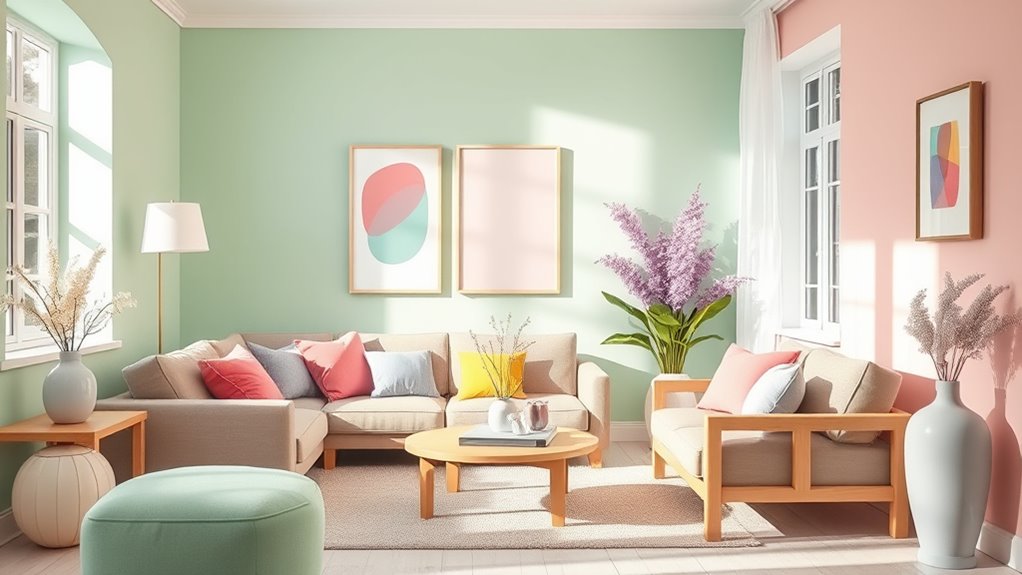
While vibrant colors can energize a space, pairing them with soothing shades creates a balanced environment that feels both lively and calming. Understanding color symbolism and psychological effects helps you select hues that promote relaxation. Bright colors like red or orange stimulate energy, but combining them with soft blues or greens can temper their intensity. This balance prevents overstimulation while maintaining visual interest. Use warm, lively tones strategically, then offset them with cool, calming shades. Here’s a simple guide:
| Bright Colors | Soothing Shades |
|---|---|
| Red, Orange | Soft Blue, Sage Green |
| Yellow | Light Gray, Lavender |
| Fuchsia | Pale Mint |
This combination nurtures both vitality and tranquility, ideal for stress relief.
Use Color Accents to Highlight Relaxation Areas

Adding color accents is an effective way to draw attention to relaxation areas in your space. By applying principles of color psychology and design, you can make these zones inviting and calming. Consider these options:
- Soft blue throw pillows on a neutral sofa to evoke tranquility.
- Gentle lavender lamps that cast a soothing glow, promoting relaxation.
- Muted green wall art that connects to nature and reduces stress.
- Warm beige rugs that create a cozy, grounding atmosphere.
These accents help guide the eye and reinforce the purpose of your relaxation space. Use contrasting yet harmonious colors to enhance focus while maintaining balance. Remember, strategic color placement leverages design principles to maximize stress relief and comfort.
Frequently Asked Questions
How Can I Combine Different Color Palettes for a Balanced Stress-Relief Space?
To combine different color palettes for a balanced stress-relief space, focus on achieving color harmony through palette blending. Start with a neutral base, then add soothing shades that complement each other. Use soft, muted tones alongside calming accents to create visual harmony. Mix warm and cool colors carefully, ensuring they blend seamlessly. This approach promotes tranquility, helping you create a space that fosters relaxation and reduces stress effectively.
What Lighting Options Best Complement Calming Color Schemes?
Studies show that lighting influences mood, supporting the idea that the right lighting enhances calming spaces. You should opt for LED fixtures with warm LEDs, as they emit a soft, gentle glow that complements soothing colors. Avoid harsh, cool lighting, which can increase stress. Instead, choose dimmable options to adjust ambiance, creating a tranquil environment that promotes relaxation and mental clarity in your stress-relief space.
Are There Specific Textures That Enhance the Soothing Effects of These Colors?
You’ll find that textured fabrics, like plush throws or soft rugs, deepen the calming effect of soothing colors, making your space feel cozy and inviting. Smooth surfaces, such as polished wooden furniture or glass accents, reflect light gently, enhancing tranquility. Combining these textures with calming hues creates a harmonious environment that eases stress. So, choose a mix of textured fabrics and smooth surfaces to boost relaxation and make your space more peaceful.
Can Color Therapy Decor Be Personalized for Individual Stress Triggers?
Imagine walking into a space where your personalized color choices instantly soothe your nerves, contrasting with the chaos outside. You can tailor your décor to address individual stress triggers by selecting colors that evoke calm or energy, depending on what you need. By customizing your environment, you actively create a sanctuary that responds to your unique emotional needs, turning everyday stress relief into a deeply personal and effective experience.
How Often Should I Update or Change My Stress Relief Color Decor?
You should update your stress relief color decor seasonally, aligning with seasonal decor trends to keep your space fresh and calming. Regular updates, every few months, help you stay connected with the latest color therapy trends and refresh your environment. Pay attention to how different colors affect your mood, and don’t hesitate to change your decor whenever you notice it no longer provides the stress relief you seek.
Conclusion
By carefully choosing these calming colors, you’ll transform your space into an oasis so peaceful, it might just make stress pack its bags forever. Soft blues and greens will cradle you in tranquility, while warm neutrals and gentle lavenders create a sanctuary where chaos is banished. With every hue, you craft a masterpiece of serenity so profound, it could make the world’s worries dissolve into nothingness—your personal refuge of ultimate relaxation.
